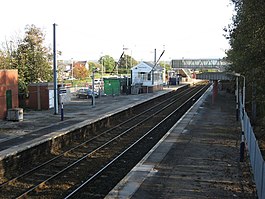Hazel Grove railway station
| Hazel Grove |
|
|---|---|

Hazel Grove railway Station
|
|
| Location | |
| Place | Hazel Grove |
| Local authority | |
| Grid reference | SJ919867 |
| Operations | |
| Station code | HAZ |
| Managed by | Northern |
| Number of platforms | 2 |
| DfT category | D |
| Live arrivals/departures, station information and onward connections from National Rail Enquiries |
|
| Annual rail passenger usage* | |
| 2011/12 |
|
| 2012/13 |
|
| 2013/14 |
|
| 2014/15 |
|
| 2015/16 |
|
| Passenger Transport Executive | |
| PTE | Transport for Greater Manchester |
| History | |
| Key dates | Opened 1857 |
| National Rail – UK railway stations | |
| * Annual estimated passenger usage based on sales of tickets in stated financial year(s) which end or originate at Hazel Grove from Office of Rail and Road statistics. Methodology may vary year on year. | |
|
|
|
Hazel Grove railway station is on the to Buxton / Sheffield line, serving the village of Hazel Grove, Greater Manchester, England. It was built for the by the London and North Western Railway and opened on 9 June 1857. From 1923 until 1948 it was owned by the London Midland and Scottish Railway and following nationalisation it was operated by the London Midland Region of British Railways.
At one time there was another station in the village (Hazel Grove (Midland)), on the Midland Railway's line from New Mills South Junction to Manchester Central via Cheadle Heath, which opened in 1902, but it was less conveniently situated and closed in 1917.
The line was extremely expensive to build with extensive earthworks. The navvies were accommodated in specially-built houses near the Rising Sun pub, which still exist, and are known as the "Navvy Mansions". The line from Edgeley Junction (just south of ) to Hazel Grove was electrified in 1981 on the 25 kV AC overhead system. This allowed EMUs on the route from Altrincham via Sale to serve the station until that line was closed for conversion to Manchester Metrolink operation in late 1991 (though electric services to and from Piccadilly continued thereafter).
The signal box on the Buxton-bound platform remains in use. This controls the junction between the Buxton line and the chord linking it to the route through Disley Tunnel towards Sheffield at the country end of the station and also a pair of carriage sidings at the Stockport end used for stabling trains that terminate here.
...
Wikipedia
